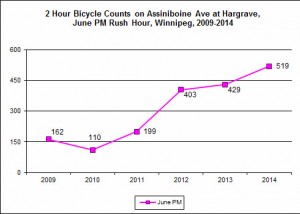The painting of bike lanes on Winnipeg’s downtown streets, which started in 2009, helped start Winnipeg’s slow march towards bikeability. And while this has encouraged an increasing number of people to use their bikes to reach their work, shopping, or entertainment destinations downtown, for many people the level of comfort and protection provided by a painted bike lane falls well short of the threshold that would convince them to abandon their car and ride their bikes downtown.
Fully 47% of people surveyed as part of the pedestrian and cycling strategy stated that the addition of protected bike lanes on main streets would encourage the to bike more or much more often. The city’s experience with the protected bike lanes on Assiniboine has shown that the pattern of seeing significant increases in the number of cyclists on roads where protected bike lanes are installed will be matched in Winnipeg.
Following the installation of a two-way protected cycle track on Assinniboine Avenue in 2010, regular counts of cycling traffic have shown that the number of cyclists traveling down Assiniboine has increased by more than 200%. Clearly, Winnipeg residents have been encouraged to switch to their bikes where protected bike lanes are provided.

Bicycle Traffic on Assiniboine Ave has increased by over 200% since a protected cycle track was installed in 2010.
Given the importance of Winnipeg’s downtown as an employment, education, shopping and education destination, the downtown protected bike lanes need to identified as the highest priority in the city’s cycling networks implementation plan.
- Highlights
- Build a new protected bike lane on York Avenue
- Upgrade from painted bike lanes to protected bike lanes on
- Fort Street
- Garry Street
- Hargrave Street
- Carlton Street
- Bannatyne Avenue
- McDermot Avenue
- St. Mary Avenue
- Compliments the existing protected lanes on Assiniboine
- Estimated Cost: $8,000,000
[osm_map lat=”49.893″ lon=”-97.14″ zoom=”14″ width=”100%” kml_file=”https://www.bikewinnipeg.ca/wp-content/uploads/maps/Downtown-Protected-Bike-Lanes.kml” type=”CycleMap”]
Downtown Protected Bike Lanes Project (in green)
